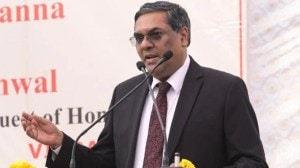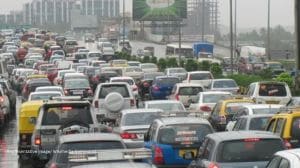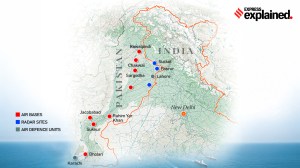UPSC Key: Corporate Social Responsibility, Globalisation and United Nations Ocean Conference
Why IMF world economic outlook is relevant to the UPSC exam? What is the significance of topics such as India Meteorological Department, Agrivoltaics and Sustainable Development Goal 14 of the Agenda 2030 on both the preliminary and main exams? You can learn more by reading the Indian Express UPSC Key for April 28, 2025.
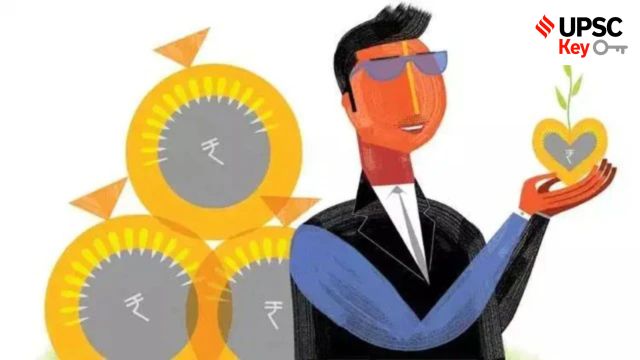 UPSC Key April 2025: Here's what you should be reading from the April 28, 2025 edition of The Indian Express
UPSC Key April 2025: Here's what you should be reading from the April 28, 2025 edition of The Indian Express
Important topics and their relevance in UPSC CSE exam for April 28, 2025. If you missed the April 27, 2025 UPSC CSE exam key from the Indian Express, read it here
FRONT PAGE
CSR spend: Listed firms record 16% rise to `17,967 cr in previous fiscal
Syllabus:
Preliminary Examination: Economic and Social Development-Sustainable Development, Poverty, Inclusion, Demographics, Social Sector Initiatives, etc.
Main Examination: General Studies IV: Corporate Governance.
What’s the ongoing story: Aided by a surge in profits, funds spent by listed companies on Corporate Social Responsibility (CSR) rose by 16 per cent to Rs 17,967 crore during the year ended March 2024 as compared to Rs 15,524 crore spent in 2022-23, says a report.
Key Points to Ponder:
• What is Corporate Social Responsibility (CSR)?
• What are the types of Corporate Social Responsibility (CSR) responsibilities?
• What Companies Act, 2013 says about Corporate Social Responsibility (CSR)?
• Corporate Social Responsibility (CSR)—How this evolved in India?
• What are the achievements of Corporate Social Responsibility (CSR) in India?
• Corporate Social Responsibility (CSR) sector wise expenditure—know in detail
• Why CSR Activities in India is important?
• Which CSR expenses are permitted? Is it possible to use CSR for election expenditures?
Key Takeaways:
• HDFC Bank topped the list with a CSR spend of Rs 945.31 crore, followed by Reliance Industries Rs 900 crore, TCS at Rs 827 crore and ONGC Rs 634.57 crore.
• The rise was due to an 18 per cent rise in average net profit (in the preceding 3 years) of these companies, two per cent of which needs to be spent on CSR activities as per regulatory requirements, and followed three years of flattish spends, from Rs 14,751 crore in 2019-20 to just Rs 15,524 crore in 2022-23, says a PRIME Database report.
• The CSR law, which came into force in April 2014, mandates companies, subject to the provisions of the Act, to invest two per cent of their net profit in CSR projects.
• Companies with net worth of Rs 500 crore and above or revenue of Rs 1,000 crore and above or net profit of Rs 5 crore and above have to spend two per cent of average net profits of last three years.
• According to Primeinfobase.com, the average net profit of 1,394 companies over last three years was Rs 9.62 lakh crore, up from Rs 8.14 lakh crore in 2022-23. As per CSR requirements, the amount required to be spent by them was Rs 18,309 crore (2022-23: Rs 15,713 crore), against which they spent a slightly lower Rs 17,967 crore (2022-23: Rs 15,524 crore). The shortfall can be explained by the increase in amount which remained unspent which was transferred by companies to Unspent CSR Account Rs 2,329 crore) for use in future years, it said.
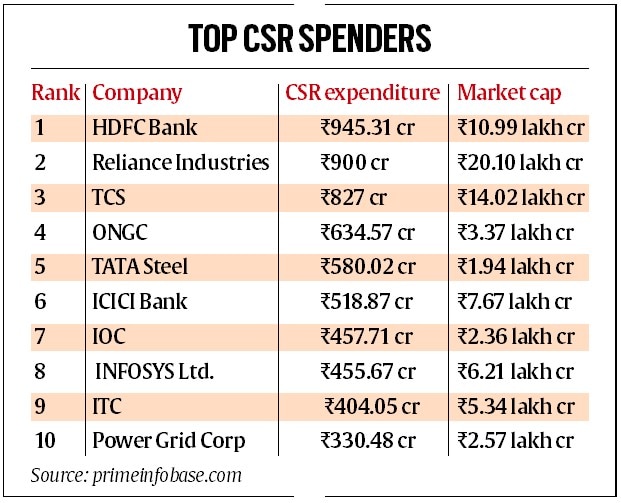
• In line with the previous years, education received the maximum spend Rs 1,104 crore) followed by healthcare Rs 720 crore). On the other hand, areas such as slum development, armed force veterans and disaster management saw lower and negligible spends.
• In comparison to previous year (only considering data of 440 companies for which project details were available for both years), spends on environmental sustainability increased the most (54 per cent) followed by spends on national heritage (5 per cent). On the other hand, contribution to slum development fell the most (72 per cent) followed by spends on rural development (59 per cent) and armed force veterans (52 per cent).
Do You Know:
• According to Investopedia, Corporate social responsibility (CSR) is a self-regulating business model that helps a company be socially accountable to itself, its stakeholders, and the public.
• Through corporate social responsibility programs, philanthropy, and volunteer efforts, businesses can benefit society while boosting their brands. A socially responsible company is accountable to itself and its shareholders.
• CSR is commonly a strategy employed by large corporations. The more visible and successful a corporation is, the more responsibility it has to set standards of ethical behavior for its peers, competition, and industry.
• According to Investopedia, there are four types of CSR—
—Environmental responsibility: Corporate social responsibility is rooted in preserving the environment. A company can pursue environmental stewardship by reducing pollution and emissions in manufacturing, recycling materials, replenishing natural resources like trees, or creating product lines consistent with CSR.
—Ethical responsibility: Corporate social responsibility includes acting fairly and ethically. Instances of ethical responsibility include fair treatment of all customers regardless of age, race, culture, or sexual orientation, favourable pay and benefits for employees, vendor use across demographics, full disclosures, and transparency for investors.
—Philanthropic responsibility: CSR requires a company to contribute to society, whether a company donates profit to charities, enters into transactions only with suppliers or vendors that align with the company philanthropically, supports employee philanthropic endeavours, or sponsors fundraising events.
—Financial responsibility: A company might make plans to be more environmentally, ethically, and philanthropically focused, however, it must back these plans through financial investments in programs, donations, or product research including research and development for products that encourage sustainability, creating a diverse workforce, or implementing DEI, social awareness, or environmental initiatives.
Other Important Articles Covering the same topic:
📍Explained: How CSR expenditure rules have changed for Indian companies
Previous year UPSC Prelims Question Covering similar theme:
1. With reference to Corporate Social Responsibility (CSR) rules in India, consider the following statements: (2024)
1. CSR rules specify that expenditures that benefit the company directly or its employees will not be considered as CSR activities.
2. CSR rules do not specify minimum spending on CSR activities.
Which of the statements given above is/are correct?
a) 1 only
b) 2 only
c) Both 1 and 2
d) Neither 1 nor 2
Previous year UPSC mains Question Covering similar theme:
📍Corporate social responsibility makes companies more profitable and sustainable. Analyse. (2017)
THE EDITORIAL PAGE
Syllabus:
Preliminary Examination: Current events of national and international importance.
Main Examination: General Studies I: Effects of globalization on Indian society.
What’s the ongoing story: The focus should now be on reforms to improve the ease of doing business and reduce compliance burdens. These would pay off when the tide turns again in favour of globalisation
Key Points to Ponder:
• What is globalisation?
• What are the effects of globalisation in India?
• How Trump’s trade policies can affect India?
• How India-Pakistan bilateral tensions can affect global market?
• What are the current global economic trend affecting India’s growth?
• What policy focus is recommended for India to navigate the challenges posed by the changing phase of globalization?
• What are the potential benefit for India amid the global shift away from traditional globalization?
• What is a significant challenge India faces due to the changing global economic landscape?
• Which sector is identified as a strength for India in maintaining economic resilience?
• What is the role of domestic reforms in enhancing India’s preparedness for shifts in global economic trends?
Key Takeaways:
• Globalisation — the free flow of goods, services, labour, capital and ideas — has been incontrovertibly beneficial for India, lifting its average annual growth rate to nearly 6.5 per cent since the early Nineties (from 3.5 per cent during 1950-1990) and per capita GDP from $320 to $2,500.
• While international trade in goods may have slowed down since 2010, the other components of globalisation haven’t, at least until recently.
• In fact, India’s export of services, particularly software and back-office/business support operations through global capability centres, has boomed in the past decade, even as it has remained the top global recipient of remittances and continued to attract capital flows. But this phase of globalisation-aided growth is increasingly facing challenges, if not coming to an end. It’s something India must be prepared for.
• The International Monetary Fund expects world goods and services trade to grow by just 1.7 per cent in 2025 and 2.5 per cent in 2026, down from its projections of 3.2 per cent and 3.3 per cent in January. The fall is even more relative to the 5.8 per cent average annual increase between 1995 and 2023, as per the World Trade Organisation’s estimates.
• The slowing down of that engine will definitely hurt India, and maybe even shave a percentage point or more off its near-term GDP growth. The overall uncertain global economic environment, whether to do with Trump’s trade policies or fears of Chinese dumping, could dampen investment and hiring plans by businesses. Escalating tensions with Pakistan, post Pahalgam, aren’t going to help either.
• The only consolation is India’s reasonably sound macroeconomic stability indicators. Annual consumer price inflation, at 3.3 per cent in March, is the lowest since August 2019. Forex reserves are at a six-month high of $686 billion after depleting to below $625 billion in mid-January. The rupee has also recovered to 85.4 to the dollar, from the near-88 lows of only two-and-a-half months ago.
• The focus should now be on reforms to improve the ease of doing business and reduce compliance burdens. These would pay off when the tide turns again in favour of globalisation.
Do You Know:
• According to the Investopedia, Globalization refers to the growing interconnection of nations’ economies. It represents the flow of financial products, goods, technology, information, and jobs across national borders and cultures. In economic terms, it describes an interdependence of countries around the globe fostered through free trade.
• Globalization is a social, cultural, political, and legal phenomenon.
• According to the Investopedia, the Components of Globalization:
—GDP is the market value of all finished goods and services produced within a country’s borders in a year and serves as a measure of a country’s overall economic output.
—Industrialization is a process driven by technological innovation that effectuates social change and economic development by transforming a country into a developed nation.
—The Human Development Index comprises a country’s population’s life expectancy, knowledge, and education measured by adult literacy and income.
Other Important Articles Covering the same topic:
Previous year UPSC Prelims Question Covering similar theme:
📍To what extent globalisation has influenced the core of cultural diversity in India? Explain. (2016)
📍Discuss the positive and negative effects of globalization on women in India. (2015)
Syllabus:
Preliminary Examination: Current events of national and international importance
Main Examination: General Studies II: Bilateral, regional and global groupings and agreements involving India and/or affecting India’s interests.
What’s the ongoing story: Thierry Mathou Writes: In the context of ever-faster climate change and overexploitation of marine resources, the ocean is not just an issue like any other: It is everyone’s business.
Key Points to Ponder:
• What is the United Nations Ocean Conference?
• The United Nations Conference on oceans 2025 or UNOC3—know its theme and host country
• Why an entire conference dedicated to the ocean and maritime topics?
• What is the Sustainable Development Goal 14 of the Agenda 2030?
• What is Biodiversity Beyond National Jurisdiction?
• What is the significance of the ‘Zero Draft’ in the context of UNOC3?
• Discuss the significance of the Third United Nations Ocean Conference (UNOC3) in advancing global ocean governance.
• Discuss the interplay between ocean health and climate change, and how international forums can address this nexus.
• What are the other important international as well as national treaties/agreements/policies on Ocean?
Key Takeaways:
Thierry Mathou Writes:
• The Indian peninsula is surrounded by an ocean, with about a third of India’s population living in coastal areas. With 7,517 km of coastline, India is among the countries whose daily life, economy and environment are most impacted by the ocean. This is acknowledged in the Indian government’s Vision 2030, which recognises the blue economy as one of the 10 core dimensions of growth.
• The ocean is a global commons — it belongs to all of us. It feeds and protects our peoples. It makes us dream and travel. It provides us with sustainable energy, the means to trade, resources, and infinite scientific knowledge.
• One in three people relies on the ocean for their livelihood, yet it is in danger. It is an area that is still largely unknown, and lacks both the global governance and the funding necessary for its preservation. The figures are worrying: More than eight million tons of plastic end up in the ocean every year, according to a study published in Science. More than a third of fish stocks suffer overfishing, while ocean acidification, rising sea levels, and the destruction of marine ecosystems gain pace as direct consequences of climate change.
• From June 9-13, France will co-host the third United Nations Ocean Conference (UNOC3) with Costa-Rica. Around 100 heads of state and government, as well as tens of thousands of researchers, scientists, economic actors, activists and citizens from around the world, will converge in Nice.
• Ten years after COP21 and the Paris Agreement, which established a binding global framework to limit climate change, the UNOC3 is a historic opportunity. The “Nice Ocean Agreements” can form an international pact for the conservation and sustainable use of the ocean, fully in line with the Sustainable Development Goals adopted by the UN in 2015. To this end, the talks in Nice need to be operational and action-focused, aiming for better governance, further financing, and greater knowledge of the seas.
Do You Know:
• The UN Ocean Conference is the United Nations conference dedicated to the Sustainable Development Goal 14 with the aim to mobilise action for the conservation, protection and sustainable use of the ocean, seas and the marine resources.
• The first UN Ocean Conference was held in June 2017 in the United Nations Headquarters in New York City (U.S.A.) and co-hosted by the Governments of Fiji and Sweden. It was composed of heads of State and Government, civil society representatives, business leaders, stakeholders, academics, scientists and ocean and marine life advocates from over 150 countries.
• The high-level 2025 United Nations Conference to Support the Implementation of Sustainable Development Goal 14: Conserve and sustainably use the oceans, seas and marine resources for sustainable development (the 2025 UN Ocean Conference) will be co-hosted by France and Costa Rica and held in Nice, France, from 9 – 13 June 2025.
• The overarching theme of the Conference is “Accelerating action and mobilizing all actors to conserve and sustainably use the ocean”.
• The Conference aims to support further and urgent action to conserve and sustainably use the oceans, seas and marine resources for sustainable development and identify further ways and means to support the implementation of SDG 14.
• The Conference will build on the previous UN Ocean Conferences, hosted by Sweden and Fiji in 2017 in New York and by Portugal and Kenya in 2022 in Lisbon.
Other Important Articles Covering the same topic:
📍UN Ocean Conference opens with calls for united action
Previous year UPSC Prelims Question Covering similar theme:
2. Consider the following in respect of Indian Ocean Naval Symposium (IONS): (2017)
1. Inaugural IONS was held in India in 2015 under the chairmanship of the Indian Navy.
2. IONS is a voluntary initiative that seeks to increase maritime co-operation among navies of the littoral states of the Indian Ocean Region.
Which of the above statements is/are correct?
(a) 1 only
(b) 2 only
(c) Both 1 and 2
(d) Neither 1 nor 2
THE IDEAS PAGE
Syllabus:
Preliminary Examination: Current events of national and international importance
Main Examination: General Studies III: Conservation, environmental pollution and degradation, environmental impact assessment.
What’s the ongoing story: Ashok Gulati and Suvangi Rath writes: Drastic steps are needed to restore the health of our planet. India’s unsustainable agricultural production system must change
Key Points to Ponder:
• What is the primary focus of the article “A revolution of clean energy”?
• What is agrivoltaics?
• What is a significant challenge in India’s renewable energy sector as highlighted in the article?
• What innovative approach combines agriculture with solar energy production?
• As per the article, what is India’s renewable energy capacity target by 2030?
• What are the environmental benefits and potential drawbacks of a large-scale shift to renewable energy in India.
Key Takeaways:
Ashok Gulati and Suvangi Rath writes:
• International Mother Earth Day was celebrated on April 22. It was established by a resolution of the General Assembly of the United Nations in 2009, although its roots lie in the 1970s.
• The main objective behind this is to promote the Harmony with Nature initiative for the sustainable development of humanity. Earth, as of now, is the only known planet to host life.
• Some major changes in Earth’s resources were inevitable as humans multiplied on this planet over the past two centuries. Although it took Homo sapiens almost 3,00,000 years to hit the 1 billion mark for the first time in 1804, we added the next billion in 123 years, by 1927. Between 1927 and 2025, we have multiplied by more than four times to cross 8 billion. India is the most populous country on this planet today, and likely to remain so till the end of this century. This exponential growth of the last century has put unprecedented pressure on this planet to produce more food, housing, clothing, and other needs of travel, etc.
• Use of fossil fuels for energy and faster travel has been one of the major factors behind global warming and the damage to air quality of the planet.
• India is not in very good shape on this. The Environment Pollution Index (EPI) 2024, as constructed by Yale University for 180 countries, puts India at 176th rank. The World Air Quality Report 2024 released by the Swiss company IQAir notes that of the 100 most polluted cities and towns globally, 74 are in India.
• Another report by the University of Chicago’s Energy Policy Institute says that people living in Delhi/NCR are cutting short their life expectancy by 11.9 years due to high air pollution.
• The Indian government may reject these findings, but the facts will not change much. It is an emergency and we know how the NCR becomes a gas chamber in November-December every year. Drastic steps are needed to restore the health of our planet.
Do You Know:
Ashok Gulati and Suvangi Rath writes:
• Policies, practices, and products have to play an important role. Innovative policies of payment for ecosystem services (PES) need to be introduced. Farming practices and products that align with nature need to be rewarded, be it in the form of carbon credits or saving soils and precious water or promoting biodiversity. Productivity growth is important but so is nature’s basic resource endowment.
• From 2000-01 to 2024-25, India has done pretty well in overall growth of GDP at 6.3 per cent per annum, and agriculture and allied sectors’ growth of 3.5 per cent per annum. This has helped India reduce poverty, feed its population, and be a net exporter of agri-produce. But policies like free power and highly subsidised fertilisers, especially urea, coupled with open-ended procurement of paddy and wheat, in places like Punjab and Haryana, are playing havoc with critical agri-ecosystem services.
• The theme of this year’s Earth Day is renewable energy, and augmenting it by 300 per cent by 2030. If farmers can be incentivised to adopt agrivoltaics as a third crop, it can help produce cleaner energy to conserve ecosystem services as well augment farmers’ incomes. It is feasible if the discoms purchase power from farmers at a price that gives a 10-15 per cent premium over the cost of generating thermal power. Then it can unleash a revolution of clean energy on farmers’ fields. We hope it can be done to protect Mother Earth and our farmers.
Other Important Articles Covering the same topic:
📍On agriculture front, an agenda for the new government
EXPLAINED
The history and evolution of monsoon forecasting in India
Syllabus:
Preliminary Examination: Current events of national and international importance.
Main Examination: General Studies I: Important Geophysical phenomena such as earthquakes, Tsunami, Volcanic activity, cyclone etc., geographical features and their location-changes in critical geographical features (including water-bodies and ice-caps) and in flora and fauna and the effects of such changes.
What’s the ongoing story: The India Meteorological Department (IMD) has forecast ‘above normal’ rainfall — 105% of the long-period average (LPA) — during the June-September southwest monsoon season.
Key Points to Ponder:
• How is Indian monsoon predicted?
• Which department in India does weather forecasting?
• What is the India Meteorological Department?
• India Meteorological Department-Know its role, responsibilities and function
• Analyse the impact of India’s diverse geography on the forecasting challenges faced by IMD.
• Examine the role of IMD in disaster management and its coordination with other agencies to enhance disaster preparedness in India.
• Highlight the significance of public communication in IMD’s operations.
• Who made the first prediction of monsoon in India?
• What is the all India monthly and seasonal rainfall?
• What do we mean by long period average (LPA) of rainfall?
• What is large excess, excess, normal, deficient, large deficient rainfall?
• What is below normal, normal and above normal rainfall for the country as a whole?
• What is the role of monsoon trough?
• What are the observational tools used for monitoring monsoon?
Key Takeaways:
• The IMD said earlier this month that all major drivers of the Indian monsoon, such as El Niño-Southern Oscillation (ENSO) in the equatorial Pacific Ocean and the Indian Ocean Dipole (IOD), were favourable.
• The four-month southwest monsoon season brings almost 70% of the country’s annual rainfall. It is critical for agriculture and crops, for the economy as a whole, and to recharge reservoirs and aquifers. Accurate forecasts of the monsoon are key for the government to prepare for a range of eventualities.
• The April 15 forecast was the first of the IMD’s long-range forecasts for this year’s monsoon. A second-stage or updated forecast will be made in the last week of May, ahead of the monsoon striking the coast of Kerala. Long-range forecasts can be made for 30 days to up to two years into the future.
• A systematic effort to forecast monsoon rainfall began in 1877, two years after the IMD was established with the British meteorologist and palaeontologist Henry Francis Blanford as the first Meteorological Reporter to the Government of India.
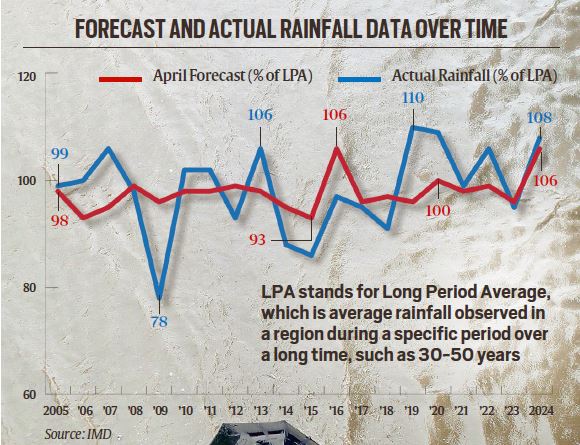 Forecast and actual rainfall data over time.
Forecast and actual rainfall data over time.
• Crop failure that began in the Deccan plateau in the previous year had set off the Great Famine of 1876-78, and the effects were felt across the country by 1877. The colonial administration saw an acute need to understand the arrival of the monsoon and the distribution of rain over the country.
• “The success of the monsoons dictated agricultural production and the health of rivers, coasts, and shipping lanes — i.e., revenue generation for British interests,” Ramesh Subramanian of Quinnipiac University in the US wrote in his paper ‘Monsoons, Computers, Satellites: History and Politics of Weather Monitoring in India’ (2021).
Do You Know:
• According to IMD website, In the year 1875, the Government of India established the India Meteorological Department, bringing all meteorological work in the country under a central authority. A disastrous tropical cyclone struck Calcutta in 1864 and this was followed by failures of the monsoon rains in 1866 and 1871. Mr. H. F. Blanford was appointed Meteorological Reporter to the Government of India. The first Director General of Observatories was Sir John Eliot who was appointed in May 1889 at Calcutta headquarters. The headquarters of IMD were later shifted to Shimla, then to Poona (now Pune) and finally to New Delhi.
• The first tentative forecasts of the monsoon were provided by Blanford between 1882 and 1885, who analysed the relationship between Himalayan snow cover and the amount of rainfall over the Indian region.
• Blanford’s forecasts were “based on the inverse relationship between Himalayan winter and spring snow accumulation and subsequent summer monsoon rainfall over India. It was assumed that, in general, varying extent and thickness of the Himalayan snow has a great and prolonged influence on the climate conditions and weather of the plains of northwest India,” the IMD says in its official account of the evolution of meteorology in India.
• In 1886, Blanford made the first long-range forecast (LRF) of monsoon rainfall for the whole of India and Burma, based on this inverse relationship hypothesis.
Blanford was succeeded by Sir John Eliot, who was appointed the first Director General of Indian Observatories, equivalent to the position of the head of the IMD today, in May 1889 at its Calcutta headquarters.
• Eliot took forward Blanford’s work, combining data on Himalayan snow with factors such as local Indian weather conditions in April-May and conditions over the Indian Ocean and Australia to issue his LRFs. But like Blanford, Eliot still could not effectively predict droughts or the famines that followed, bringing starvation and deaths. The Indian Famine of 1899-1900, which is estimated to have killed between a million and 4.5 million people, struck in a year for which Eliot had predicted better-than-normal rain. The first colonial official who sought to incorporate the influence of global factors on the Indian monsoon was the physicist and statistician Sir Gilbert Walker, who succeeded Eliot in 1904.
• The IMD stayed with Walker’s model of monsoon forecasting until 1987. The forecasts were not very accurate. “The average error of the predictions for the peninsula was 12.33 cm and 9.9 cm for NW India during the period 1932-1987,” M Rajeevan, a former Secretary to the Ministry of Earth Sciences, and IMD Scientist D R Pattanaik wrote in their paper, ‘Evolution of Monitoring and Forecasting of Southwest Monsoon’ (Mausam, IMD’s quarterly journal, 2025).
• Forecasts in recent years—
—The improvement in monsoon prediction was also due to the launch of the Monsoon Mission Coupled Forecasting System (MMCFS) in 2012. This was a coupled dynamic model, which could combine data from the ocean, atmosphere, and land to provide more accurate forecasts. The IMD used MMCFS along with the SEFS for its predictions.
—MULTI-MODEL ENSEMBLE: The accuracy of forecasts was further enhanced with the launch of a system based on a “multi-model ensemble (MME)” in 2021. This new MME system used the coupled global climate models (CGCMs) from various global climate prediction and research centres, including India’s own MMCFS model.
—BETTER FORECASTS, SCOPE FOR IMPROVEMENT: The absolute forecast error in all of India’s seasonal rainfall reduced by about 21% during the years 2007-2024 compared with the same number of years between 1989 and 2006, Earth Sciences Minister Dr Jitendra Singh told Rajya Sabha.
Other Important Articles Covering the same topic:
📍Why India Meteorological Department (IMD) needs an upgrade, with climate change impacting weather
IMF REPORT OUT, CHINA MOVES TO ADJUST TO NEW TRADING ORDER
Syllabus:
Preliminary Examination: Current events of national and international importance.
Main Examination: General Studies I: Important International institutions, agencies and fora- their structure, mandate
What’s the ongoing story: IMF World Economic Outlook: In the US, a Federal Reserve report highlights people rushing to buy cars before tariffs kick in. In China, businesses forced to ‘look west’.
Key Points to Ponder:
• What is the IMF world economic outlook?
• What are the Key Highlights of the latest world economic outlook report?
• What is the International Monetary Fund?
• Why IMF world economic outlook has slashed growth projections for most countries, including India?
• How escalating global trade tensions impacting on India’s economic growth prospects?
• Know the role of rural private consumption in sustaining India’s economic growth amid global uncertainties.
Key Takeaways:
• Our tariff tracker earlier this week had highlighted that two economic health indicators of the US and the world would be out soon. These reports are out now, one by the International Monetary Fund and the other by the US Federal Reserve (equivalent of India’s RBI). In both, the common sentiment is of warnings against uncertainty, unpredictability, etc.
• The IMF in its World Economic Outlook says, “…the landscape has changed as governments around the world reorder policy priorities and uncertainties have climbed to new highs…Ratcheting up a trade war and heightened trade policy uncertainty may further hinder both short-term and long-term growth prospects.”
• The US Fed’s Beige Book says, “Economic activity was little changed since the previous report, but uncertainty around international trade policy was pervasive across reports…The outlook in several Districts worsened considerably as economic uncertainty, particularly surrounding tariffs, rose.”
• Uncertainty is indeed pervasive across the global financial system, as the world waits for the 90-day pause on US President Donald Trump’s tariffs to end in July. There’s no way to know whether the unprecedentedly high tariffs — slapped on both friends and foes — will stay, and in what form.
• Trump’s officials had earlier said they would strike “90 deals in 90 days” with countries bilaterally for a trade system “fairer” to the US. However, no one knows what level of negotiations any of these deals have reached, especially as the US President continues to make contradictory and completely unsubstantiated claims about negotiations.
Do You Know:
• The IMF said the global economy seemed to have stabilised, but growth rates, though steady, were “underwhelming”.
• The World Economic Outlook (WEO) is a survey of prospects and policies by the IMF staff, usually published twice a year, with updates in between. It presents analyses and projections of the world economy in the near and medium term, which are integral elements of the IMF’s surveillance of economic developments and policies in its member countries and of the global economic system. They consider issues affecting advanced, emerging and developing economies, and address topics of pressing current interest.
Other Important Articles Covering the same topic:
Previous year UPSC Prelims Question Covering similar theme:
3. ‘Global Financial Stability Report’ is prepared by the (2016)
(a) European Central Bank
(b) International Monetary Fund
(c) International Bank for Reconstruction and Development
(d) Organization for Economic Cooperation and Development
Question before SC: are ‘unopposed’ election victories unconstitutional?
Syllabus:
Preliminary Examination: Current events of national and international importance.
Main Examination: General Studies II: Salient features of the Representation of People’s Act.
What’s the ongoing story: The Supreme Court suggested last week that in case there is only one candidate in an election, she should be required to obtain a prescribed minimum vote share in order to be declared elected, rather than winning without the election being held.
Key Points to Ponder:
• What recent suggestion did the Supreme Court of India make regarding unopposed elections?
• Which section of the Representation of the People Act, 1951, currently allows unopposed candidates to be declared elected without voting?
• What is the main concern of the Supreme Court regarding unopposed elections?
• What does NOTA stand for in the context of elections?
• According to the Election Commission, how has the NOTA option performed since its introduction?
• What is the primary purpose of introducing a minimum vote threshold for unopposed candidates?
Key Takeaways:
• The court was hearing a petition by legal research think tank Vidhi Centre for Legal Policy questioning the constitutionality of Section 53(2) of The Representation of the People Act, 1951, as far as Lok Sabha and Assembly elections are concerned.
• This section (“Procedure in contested and uncontested elections”) says that “if the number of…candidates is equal to the number of seats to be filled, the returning officer shall forthwith declare all such candidates to be duly elected to fill those seats”.
• The court has asked the Union government to file its response within four weeks.
• The petition, filed in August 2024, argues that not holding the election in case of a single candidate prevents voters from choosing the “None of the Above” (NOTA) option, which amounts to a violation of their fundamental right.
• The petition cites the Supreme Court’s 2013 judgment in People’s Union for Civil Liberties vs Union of India, in which the court held that the right to cast a negative vote by choosing NOTA was protected in direct elections under Article 19(1)(a) of the Constitution.
• It argues that “this right, by which the voter indicates her disapproval of the entire field of candidates, must be agnostic to the number of candidates in the fray”.
Do You Know:
• Candidates were elected uncontested to Lok Sabha at 26 constituencies between 1951 and 2024, the petition says, citing statistical reports of the Election Commission of India for these years. As such, more than 82 lakh electors had been deprived of the chance to cast their vote in these elections, it says.
• The Supreme Court directed the Election Commission of India (ECI) to introduce the NOTA option for voters in September 2013, in order to protect the secrecy of voters’ choice.
• In 2004 the People’s Union for Civil Liberties (PUCL) had approached the apex court seeking directions to the ECI for measures to protect the ‘right to secrecy’ of voters to exercise their franchise. They argued that the Conduct of Elections Rules, 1961 violated the secrecy aspect as the Presiding Officer (from the ECI) maintains a record of voters who choose not to vote along with the signatures or thumb impressions of each voter who exercises this right.
• Moreover, with the introduction of EVMs, the court noted that anyone present in the polling booth would know if a voter has decided not to vote, as the machine would not emit any light or sound (as it does when a vote is cast). The court noted that the ECI in 2001 sent a letter to the Ministry of Law and Justice seeking the introduction of a NOTA option in EVMs and ballot papers to protect voter secrecy as well as allow voters to “express his dissent/disapproval against the contesting candidates and will have the benefit of reducing bogus voting.”
Other Important Articles Covering the same topic:
📍Consider mandating minimum vote share even for unopposed candidate: SC to Centre
Previous year UPSC Mains Question Covering similar theme:
📍Discuss the role of the Election Commission of India in the light of the evolution of the Model Code of Conduct. (2022)
📍To enhance the quality of democracy in India the Election Commission of India has proposed electoral reforms in 2016. What are the suggested reforms and how far are they significant to make democracy successful? (2017)
| PRELIMS ANSWER KEY |
| 1.(a) 2.(b) 3.(b) |
For any queries and feedback, contact priya.shukla@indianexpress.com
Subscribe to our UPSC newsletter. Stay updated with the latest UPSC articles by joining our Telegram channel – IndianExpress UPSC Hub, and follow us on Instagram and X.
Must Read
Buzzing Now
May 13: Latest News
- 01
- 02
- 03
- 04
- 05





